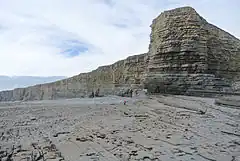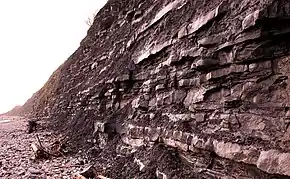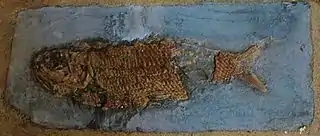| Blue Lias Formation | |
|---|---|
| Stratigraphic range: Rhaetian-Lower Sinemurian Planorbis-Semicostatum ~ | |
 Lower Lias sequence exposed at Nash Point, Glamorgan, Wales | |
| Type | Geological formation |
| Unit of | Lias Group |
| Sub-units | Wilmcote Limestone Member, Saltford Shale Member, Rugby Limestone Member |
| Underlies | Charmouth Mudstone Formation |
| Overlies | Lilstock Formation |
| Thickness | up to 120 metres (390 ft) |
| Lithology | |
| Primary | Limestone |
| Other | Mudstone |
| Location | |
| Region | Europe |
| Country | United Kingdom |
| Extent | South West England, Wales |
| Type section | |
| Location | Saltford railway cutting |
The Blue Lias is a geological formation in southern, eastern and western England and parts of South Wales, part of the Lias Group. The Blue Lias consists of a sequence of limestone and shale layers, laid down in latest Triassic and early Jurassic times, between 195 and 200 million years ago. The Blue Lias is famous for its fossils, especially ammonites.
Its age corresponds to the Rhaetian to lower Sinemurian stages of the geological timescale, thus fully including the Hettangian stage. It is the lowest of the three divisions of the Lower Jurassic period and, as such, is also given the name Lower Lias. Stratigraphically it can be subdivided into three members: the Wilmcote Limestone, Saltford Shale and Rugby Limestone.[1]
Lithology and facies
The Blue Lias comprises decimetre scale alternations of argillaceous limestone and mudstone. These alternations are caused by short-term climatic variations during the Early Jurassic attributed to orbital forcing (Milankovitch cycles). These limestone-mudstone alternations pass up into a clay member formerly known as the Lower Lias Clay now the Charmouth Mudstone. This lithology consists of monotonous mudstones weathering to clay at the surface. Sparse thin limestone and nodule bands are seen where the rocks are exposed. The deposition of a clay-rich mudstone member normally indicates deposition in a deeper marine environment. The lowest beds of the formation are referred to as the "Pre-planorbis beds" in reference them being deposited before the first appearance of the ammonite Psiloceras planorbis.
Wilmcote Limestone
In certain restricted parts of Britain, the lowermost member of the Blue Lias is the Wilmcote Limestone. It lies above the Cotham Member of the Lilstock Formation and beneath the Saltford Shale Member.[2] The Wilmcote Limestone of central England was formerly quarried close to Stratford-upon-Avon, for example at Wilmcote, Temple Grafton and Binton. It is roughly 200 million years old, dating back to the dawn of the Jurassic Period.
Much of the Wilmcote Limestone is very fine-grained, blue-grey when fresh, and very finely layered. Fossils are quite rare, except in the lowest beds. It was formerly used for a variety of purposes, including walling, building, paving, gravestones, cement-making and as a source of agricultural lime. It is no longer quarried, and most of the old quarries are either infilled or overgrown.
Geologists think that the Wilmcote Limestone originated as layers of fine-grained mud on the floor of a sheltered, shallow muddy sea or lagoon that covered parts of central England at the dawn of the Jurassic Period. Very little life could tolerate the stagnant conditions on the seabed. As a consequence the mud was seldom disturbed, which is why the fine, paper-like layering is preserved.
Above the sea bed, the shallower waters supported ammonites, fish, and marine reptiles (ichthyosaurs and plesiosaurs). Their remains were discovered in the Wilmcote Limestone quarries during the nineteenth century. The Warwickshire Museum[3] houses a collection of these fossils and some are on display at the Market Hall Museum in Warwick.[4][5]
Occurrence

The Blue Lias is a prevalent feature of the cliffs around Lyme Regis and Charmouth, on the Jurassic Coast in Dorset, where it exists in layers of limestone interspersed with softer clay. It is also notable for its presence in Somerset, particularly around the Polden Hills, Keinton Mandeville and Glastonbury area, and it forms a broad plain across the East Midlands. It also appears near Whitby in Yorkshire and Southam in Warwickshire where a pub is named after it. There are outcrops along the coast of South Wales, notably that of the Vale of Glamorgan.[6] The type section of the Blue Lias is at Saltford near Bath.
Use in construction

Blue Lias is useful as a building stone, and as a source of lime for making lime mortar. Because it is argillaceous, the lime is hydraulic. Since the mid-nineteenth century, it has been used as a raw material for cement, in South Wales, Somerset, Warwickshire, and Leicestershire. The cement plant quarry at Rugby, Warwickshire is probably the best exposure of the formation: more than 100 layers can be seen.
In areas where Blue Lias is quarried it has been used in buildings and churches as well as tombstones in cemeteries. An example of a Blue Lias town is Street, near Glastonbury. Other examples of Blue Lias buildings can be found in the nearby towns of Somerton and Ilchester.
It remains popular in more modern-day surroundings where it is used in the construction of new housing developments and extensions for existing buildings in conservation areas. Blue Lias is mainly used in flooring, walling and paving slabs – both coursed and layered. It is also used in the making of flagstones and cobbles.
There are only four quarries in Somerset quarrying Blue Lias at present. AR Purnell at Ashen Cross Quarry in Somerton have been mining blue lias stone since 1996. Hadspen Quarry Ltd. Hadspen Quarry operate one in Keinton Mandeville. Ham & Doulting Stone Co Ltd. operate one of these, Tout Quarry near Somerton.[7]
Paleofauna
The rock is rich in fossil remains from the Jurassic period. The blue-grey colour is provided by its iron content, enclosed to a large extent in pyrites.[8]
Dinosaurs
| Dinosaurs of the Blue Lias | ||||||
|---|---|---|---|---|---|---|
| Genus | Species | Location | Stratigraphic position | Material | Notes | Images |
| Dracoraptor | D. hanigani | Lavernock Point | Pre-planorbis Beds, lowermost Hettangian | NMW 2015.5G.1–2015.5G.11 "a disarticulated, but associated partial skeleton" | A coelophysoid theropod |  |
| Sarcosaurus | S. woodi | Wilmcote | angulata zone, late Hettangian (NHMUK PV R3542) Rugby Limestone Member liasicus to semicosatum zones, lowermost Sinemurian (WARMS G667–690) | Paratype specimens: NHMUK PV R3542, complete right tibia WARMS G667–690, partial skeleton | Basal neotheropod, holotype specimen is known from the Scunthorpe Mudstone | |
Pterosaurs
| Pterosaurs of the Blue Lias | ||||||
|---|---|---|---|---|---|---|
| Genus | Species | Location | Stratigraphic position | Material | Notes | Images |
| Dimorphodon | D. macronyx | Aust Cliff, Lyme Regis | NHMUK PV R 1034, NHMUK PV OR 41212, NHMUK PV R 1035 | A basal pterosaur |  | |
Fish
Numerous fish species are known from the Blue Lias and overlying Charmouth Mudstone.
| Fish of the Charmouth Mudstone Formation | ||||||
|---|---|---|---|---|---|---|
| Genus | Species | Location | Stratigraphic position | Material | Notes | Images |
| Acrodus | A hybodont shark | |||||
| Hybodus | A hybodont shark | |||||
| Palidiplospinax | A synechodontiform shark | |||||
| Squaloraja | S. tenuispina, S. polyspondyla | Closely related to modern chimaeras | ||||
| Myriacanthus | M. paradoxus, M. granulatus | A myriacanthid closely related to modern chimaeras | ||||
| Dorsetichthys | D. bechei | A stem-group teleost |  | |||
| "Coccolepis" | "C." liassicus | A coccolepidid fish, probably does not belong to the genus | ||||
| Holophagus | H. gulo | A coelacanth | ||||
| Chondrosteus | C. acipenseroides | A chondrosteid acipenseriform fish, related to sturgeon and paddlefish |  | |||
| Oxygnathus | O. ornatus | A palaeonisciform fish | ||||
| Saurorhynchus | S. brevirostris, S. anningae | A member of Saurichthyiformes | ||||
| Ptycholepis | P. gracilis, P. curtus | A palaeonisciform fish | ||||
| Dapedium | Spp. | A dapediiform fish | ||||
| Caturus | Spp. | An amiiform fish related to bowfins | ||||
| Platysiagum | P. sclerocephalum | A platysiagid fish | ||||
| Furo | F. orthostomus | A member of Ionoscopiformes within Halecomorphi | ||||
Ichthyosaurs
| Ichthyosaurs of the Blue Lias | ||||||
|---|---|---|---|---|---|---|
| Genus | Species | Location | Stratigraphic position | Material | Notes | Images |
| Ichthyosaurus | I. larkini[9] | Somerset | Unknown, possibly Pre-planorbis beds | Holotype: BRSUG 25300, referred: AGC 11, CAMSM J5957, NHMUK PV OR5595 | ||
| I. somersetensis[9] | Holotype: ANSP 15766 referred: BRSMG Cb4997, NHMUK PV OR2013AGC 16, ROM 26029 | |||||
| I. communis[10] | Somerset | Unknown | BMNH R1162 | |||
| Protoichthyosaurus | P. prostaxalis[11] | Somerset | Unknown, probably Pre-planorbis beds | Holotype: BRLSI M3553, "a partial skull, pectoral girdle and both forefins, preserved in ventral view" | ||
| Wahlisaurus | W. massarae[12] | Sutton Hill (Stowey) Quarry, Bishop Sutton | Pre-planorbis beds | BRSMG Cg240, "a practically complete right coracoid" | ||
| ?Shastasauridae | Indeterminate | Penarth | Psiloceras planorbis Biozone | NMW95.61G.1, radius[13] | Estimated length of 12–15 metres | |
| Temnodontosaurus[14] | T. platyodon | PV R 1158, consisting of a Skull, Lower Jaw and Cervical Vertebrae | ||||
Plesiosaurs
| Plesiosaurs of the Blue Lias | ||||||
|---|---|---|---|---|---|---|
| Genus | Species | Location | Stratigraphic position | Material | Notes | Images |
| Atychodracon | A. megacephalus[15] | Street-on-the-Fosse | Lowermost Blue Lias | Holotype:BRSMG Cb 2335 | Rhomaleosaurid |  |
| Avalonnectes | A. arturi[16] | Street, Somerset (referred specimen) | NHMUK 14550, "the posterior portion of the skull, and a partial postcranial skeleton" uncatalogued partial specimen | Rhomaleosaurid |  | |
| Eurycleidus | E. arcuatus | Street | BMNH 2030 (lectotype), 2027-2029, 2047, 2061, R1317-1319 (paralectotypes, probably belonging to the same individual) | Rhomaleosaurid | ||
| Eoplesiosaurus | E. antiquior[16] | Watchet, Somerset | TTNCM 8348, postcranial skeleton | Basal Plesiosauroid |  | |
| Stratesaurus | S. taylori[16] | Street, Somerset | lowermost Hettangian | OUMNH J.10337, "a skull and partial postcranial skeleton including anterior cervical and pectoral vertebrae, a partial hindlimb and ilium" | Rhomaleosaurid |  |
| Thalassiodracon | T. hawkinsii | Street | Pre-planorbis Beds | BMNH 2018 "almost complete skeleton missing distal parts of limbs" CAMSM J.35181, partial skeleton | Pliosaurid affinities[17] |  |
Insects
Insect compression fossils are known from the localities of Binton in Warwickshire and Copt Heath near Birmingham.[18]
See also
References
- ↑ Ambrose, K.; 2001: The lithostratigraphy of the Blue Lias Formation (Late Rhaetian–Early Sinemurian) in the southern part of the English Midlands Archived 7 March 2006 at the Wayback Machine, Proceedings of the Geologists' Association 112(2), pp. 97-110.
- ↑ "Wilmcote Limestone Member". The BGS Lexicon of Named Rock Units. British Geological Survey. Retrieved 20 April 2014.
- ↑ "Museum Service – Warwickshire Heritage and Culture". Archived from the original on 21 April 2014. Retrieved 20 April 2014.
- ↑ Ambrose, K., 2001. The lithostratigraphy of the Blue Lias Formation (Late Rhaetian - Early Sinemurian) in the southern part of the English Midlands. Proceedings of the Geologists' Association vol. 112, 97-110.
- ↑ Williams, B.J. & Whittaker, A., 1974. Geology of the Country around Stratford-upon-Avon and Evesham. Memoirs of the Geological Survey of Great Britain. HMSO, London.
- ↑ Wilson et al., 1990 Geology of the South Wales Coalfield, Part VI, the country around Bridgend Mem Br Geol Surv sheet 261 & 262 (England and Wales)
- ↑ "Strategic Stone Study: A Building Stone Atlas of Somerset and Exmoor" (PDF). English Heritage. p. 11. Retrieved 11 October 2011.
- ↑ Weishampel, David B; et al. (2004). "Dinosaur distribution (Early Jurassic, Europe)." In: Weishampel, David B.; Dodson, Peter; and Osmólska, Halszka (eds.): The Dinosauria, 2nd, Berkeley: University of California Press. Pp. 532–534. ISBN 0-520-24209-2.
- 1 2 Lomax, Dean R.; Massare, Judy A. (February 2017). Benson, Roger (ed.). "Two new species of Ichthyosaurus from the lowermost Jurassic (Hettangian) of Somerset, England". Papers in Palaeontology. 3 (1): 1–20. Bibcode:2017PPal....3....1L. doi:10.1002/spp2.1065. S2CID 89567182.
- ↑ Mcgowan, Christopher (1989). "Computed Tomography Reveals Further Details of Excalibosaurus, a Putative Ancestor for the Swordfish-Like Ichthyosaur Eurhinosaurus". Journal of Vertebrate Paleontology. 9 (3): 269–281. Bibcode:1989JVPal...9..269M. doi:10.1080/02724634.1989.10011762. JSTOR 4523265.
- ↑ Lomax, Dean R.; Massare, Judy A.; Mistry, Rashmiben T. (3 September 2017). "The taxonomic utility of forefin morphology in Lower Jurassic ichthyosaurs: Protoichthyosaurus and Ichthyosaurus". Journal of Vertebrate Paleontology. 37 (5): e1361433. Bibcode:2017JVPal..37E1433L. doi:10.1080/02724634.2017.1361433. ISSN 0272-4634. S2CID 90238537.
- ↑ Lomax, Dean R.; Evans, Mark; Carpenter, Simon (January 2019). Somerville, Id (ed.). "An ichthyosaur from the UK Triassic-Jurassic boundary: A second specimen of the leptonectid ichthyosaur Wahlisaurus massarae Lomax 2016". Geological Journal. 54 (1): 83–90. Bibcode:2019GeolJ..54...83L. doi:10.1002/gj.3155. S2CID 134448865.
- ↑ Martin, Jeremy; Vincent, Peggy; Suan, Guillaume; Sharpe, Tom; Hodges, Peter; Williams, Matt; Howells, Cindy; Fischer, Valentin (2014). "A mysterious giant ichthyosaur from the lowermost Jurassic of Wales". Acta Palaeontologica Polonica. doi:10.4202/app.00062.2014.
- ↑ "PV R 1158". NHM Data Portal. NHM. Retrieved 10 August 2022.
- ↑ Smith, As (2015). "Reassessment of 'Plesiosaurus' megacephalus (Sauropterygia: Plesiosauria) from the Triassic-Jurassic boundary, UK". Palaeontologia Electronica. 18 (1): 1–20. doi:10.26879/504. ISSN 1094-8074.
- 1 2 3 Benson, Roger B. J.; Evans, Mark; Druckenmiller, Patrick S. (16 March 2012). Lalueza-Fox, Carles (ed.). "High Diversity, Low Disparity and Small Body Size in Plesiosaurs (Reptilia, Sauropterygia) from the Triassic–Jurassic Boundary". PLOS ONE. 7 (3): e31838. Bibcode:2012PLoSO...731838B. doi:10.1371/journal.pone.0031838. ISSN 1932-6203. PMC 3306369. PMID 22438869.
- ↑ Benson, Roger B. J.; Bates, Karl T.; Johnson, Mark R.; Withers, Philip J. (May 2011). "Cranial anatomy of Thalassiodracon hawkinsii (Reptilia, Plesiosauria) from the Early Jurassic of Somerset, United Kingdom". Journal of Vertebrate Paleontology. 31 (3): 562–574. Bibcode:2011JVPal..31..562B. doi:10.1080/02724634.2011.572937. ISSN 0272-4634. S2CID 39844147.
- ↑ Kelly, Richard S.; Ross, Andrew J.; Coram, Robert A. (2018). "A Review of Necrotauliids from the Triassic/Jurassic of England (Trichoptera: Necrotauliidae)". Psyche: A Journal of Entomology. 2018: 1–12. doi:10.1155/2018/6706120. hdl:1983/06ae01fb-06bc-41d0-bcbd-f7519cb07df6. ISSN 0033-2615.
External links
- "Explore the Jurassic Coast" at the National Trust
- The Philpot Museum website
- Geology of Whitby
- Geology of Lyme Regis Area
- Geology of the Wessex Coast
- Ham & Doulting Stone Co Ltd
- Conservation of Blue lias article
- Fossils of the Blue Lias Formation -- A quick guide
- Hadspen Quarry Ltd
- AR Purnell Ltd
- Blue Lias, Stockton